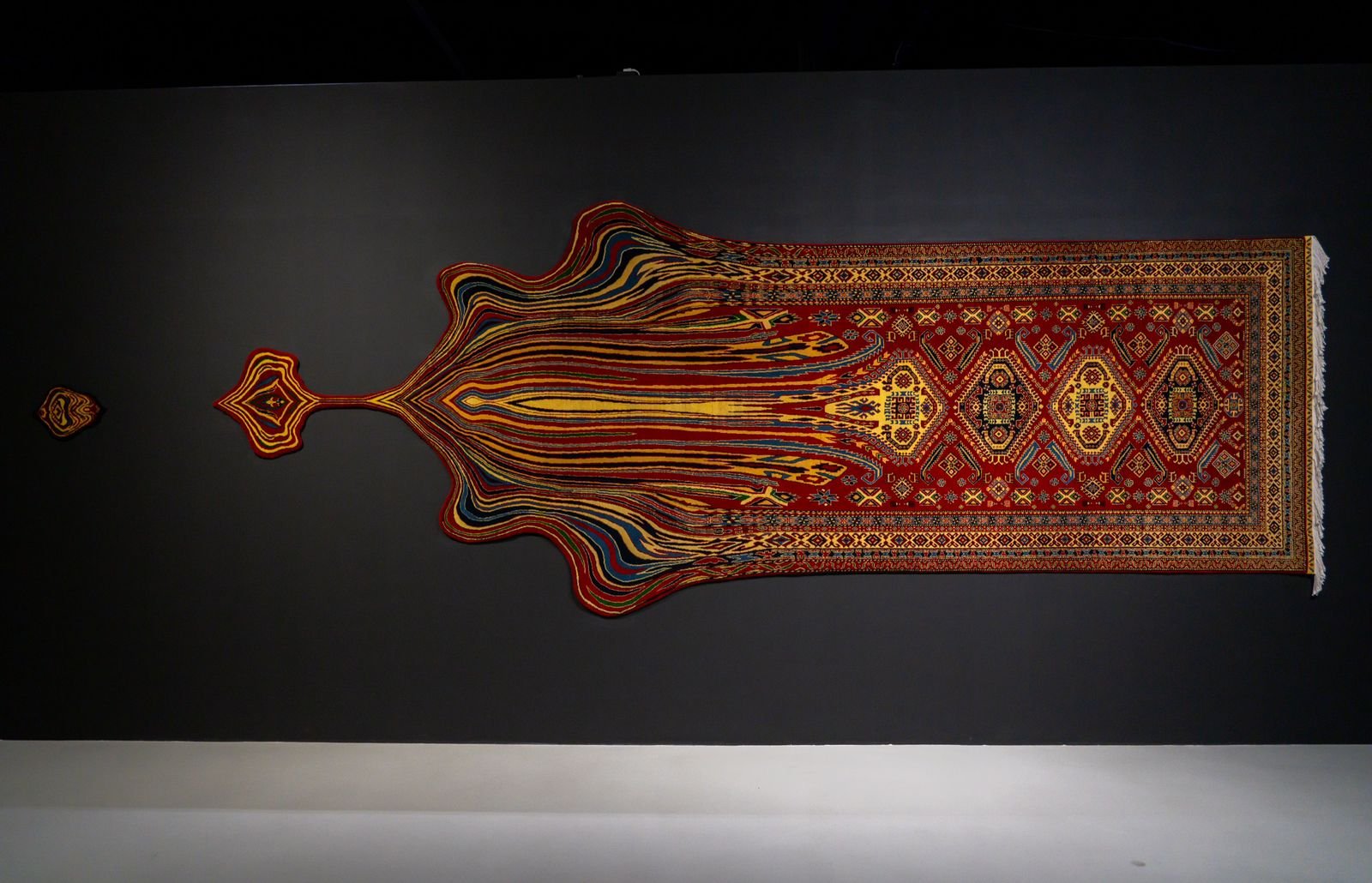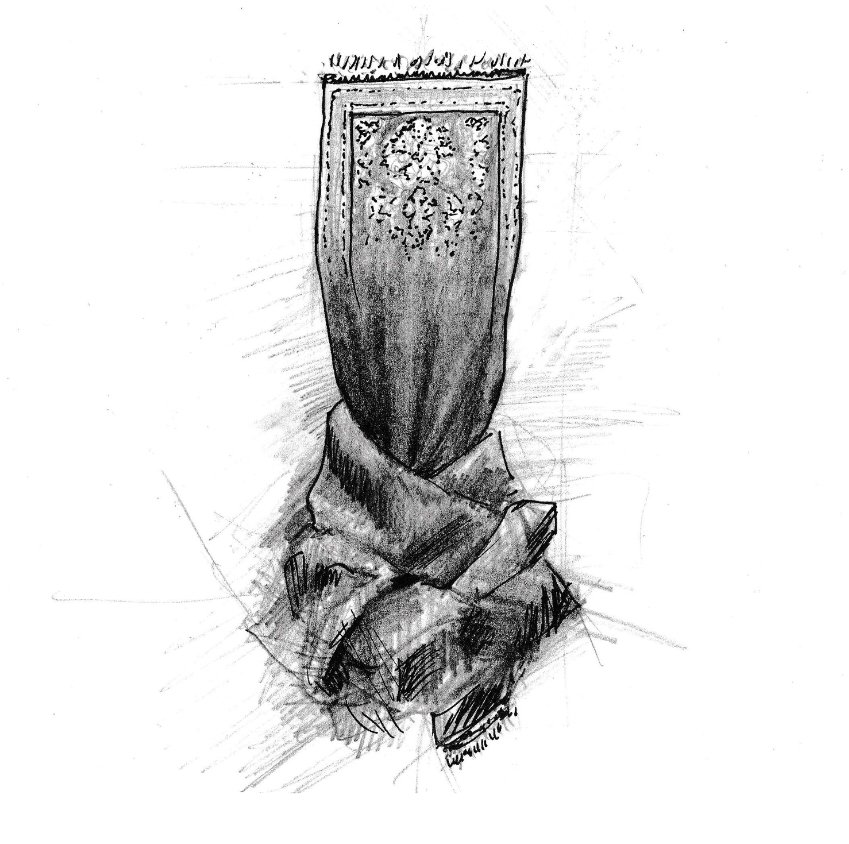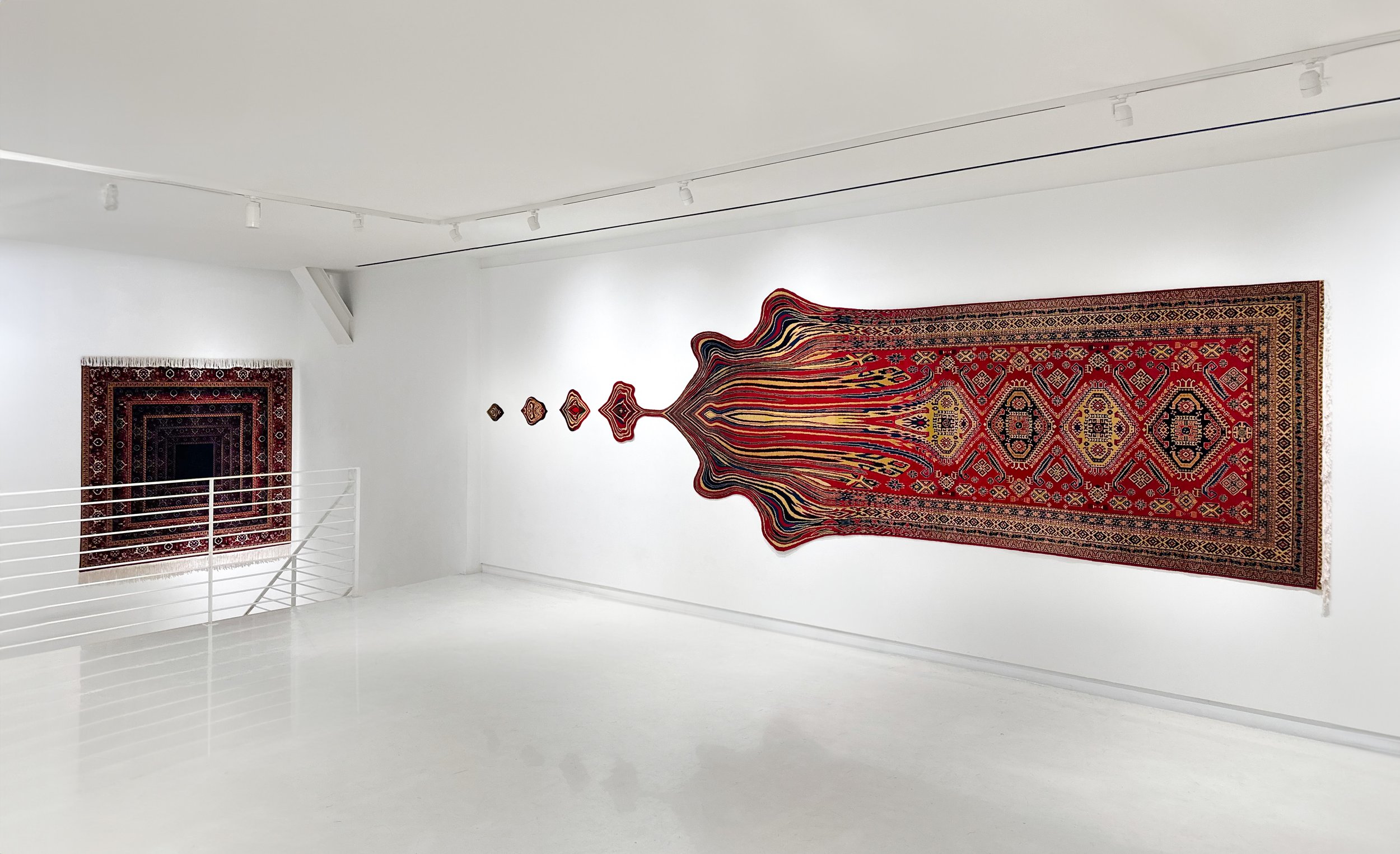THE KNOT
Faig Ahmed (Azerbaijan)
November 22, 2024 - January 6 , 2025
Essay by Donna Honarpisheh, Associate Curator of Knight Art and Research at the Institute of Contemporary Art in Miami


















Sapar Contemporary is proud to present The Knot, the gallery’s third solo exhibition of work by Azerbaijani artist Faig Ahmed (Azerbaijan). Ahmed’s new works build from his longstanding interest in textiles and carpet weaving as cultural tradition, object of heritage and historical legacy, as well as a formal technique, which inspires the artist’s contemporary reimaginings. New works featured in this exhibition are based on Shirvanshah, Karabakh, and Tabriz carpet patterns and invoke the spiritual, philosophical, and literary traditions of these regions and the carpets that came from them.
Faig Ahmed’s sculptural textile works are rooted in West and Central Asian art histories and literary poetic traditions, which draw on the transmedial relationship between text and image, mystical writing, and mathematical compositions. Each work encodes a range of transnational references to local communities across Azerbaijan, Iran, and the broader region; however, Ahmed’s warping of each carpet establishes each work beyond its historical patterning and invites the viewer to engage with the carpet as an experiential work of art. The formal aspects of carpet-making, including the repetitive and invisible labor of weaving knots are rendered visible through a distortion of scale that foregrounds the knot as a singular and integral structural form. Ahmed’s sculptural rugs are attuned to the intermedial quality of carpets and the stories they tell, but rather than reproducing them as whole, it is through the artist’s conceptual act of unraveling that the carpet reveals its mystical dimensions. For Ahmed, the carpet is neither an object of ornament nor is it merely a surface pattern. The carpet contains references to diverse practices, ideas, and stories, while also functioning itself as a medium.
This attunement to medium characterizes Ahmed’s work and unfetters the carpet from any possible understanding of it as mere surface and emphasizes its constitutive formal structures. Ahmed approaches the carpet as a series of knots and mechanisms that dialectically oscillate between mathematical precision and larger cosmological questions of hidden narratives, poetics, architectural design, and creation. By taking apart textile patterns through a gesture of destruction, which can involve unraveling, erasure, fracture, and even spillage, these works reorient the viewer’s gaze to the fundamental formal elements of each work. In other words, Ahmed’s unraveling is an act of creation that reveals key aspects therein each work.
A new work, Shirvanshah, refers to the geographic area of Shirvan (a territory of contemporary Azerbaijan), a historic area in which early churches, mosques, and synagogues were established. In the 12th century, this region served as a focal point of Persian literature, drawing in poets like Nizami Ganjavi (1141–1209), who brought colloquial Persian to the epic and transformed the genre. Shirvanshah, which is designed based on a traditional pattern from the region, transforms halfway through the piece, blurring its pattern and spilling from the wall onto the surface of the floor. The sudden glitch-like quality of the work might appear as a sudden distortion but if seen in a different way, it renders the traditional pattern into parts of a whole, bringing into new clarity line, shape, and color. Similarly, the work Gen-Culture carries ties to regional styles of carpet-making and combines several distinct patterns from various carpet schools into a single work of art. The work begins with the traditional Shirvan-Quba carpet design, followed by the red Karabakh patterns, along with deep blue sections which represents a Tabrizi style that flows into patterns of the Gazakh group. Amid this amalgamation of styles, the traditional designs mutate into a glitch effect that resembles DNA coding. Rather than create a stark contrast between past and present, the design mutation reveals a sense of motion and rupture that links the regional communities referenced across these patterns, while also bridging the human and the digital realm.
Along with works like Shirvanshah, Ahmed’s work in general is deeply inspired by the Persian poetry of Nizami Ganjavi (born in the city of Ganja, modern-day Azerbaijan), who famously wrote a set of 5 masnavīyāt, each in a different structural meter, totaling nearly 29,000 couplets in all. Nizami’s 12th century epic poem, Khosrow Shirin is structured through the hajaz meter style – a quantitative verse meter with a couplet (bayt) rhyming pattern. Most readings of Khosrow va Shirin focus on the details of the canonical story in which a tragic love triangle develops between the Armenian princess, Shirin, at its center, the Sassanian king Khosrow Parviz, and Farhad, a sculptor. Khosrow and Farhad are presented as polarized figures, with Khosrow representing a material and earthly love, while Farhad represents a divine love that is so selfless it exceeds the material world. Though the epic distills poetic insights on transcendent and earthly love, it is presented through a very precise poetic pattern creating a formal quality that is as captivating as the narrative unfolding. There is a dialectical quality between the feelings and experiences that exceed structure and the structural forms that manifest those creations. Herein the relationship between part and whole, spirit and structure, and intermediality lies the conceptual resonance with Ahmed’s work.
Throughout the epic, Nizami’s preoccupation with the act of creation is critical to an understanding of the epic. The early Persian painter Mani is referenced throughout the text as an image of aesthetic perfection and is tied to the Manichean belief that the arts, namely calligraphy, painting, and music are of equal value to the divine. Before the epic, the text begins with an esgh nameh, a speech on love, announcing love as the ultimate act of creation. As the text continues, the reader observes the ways in which Nizami weaves multiple other creative forces into the narrative: painting recurs prominently as the force that traces Shirin’s symmetrical features, Farhad’s character is a sculptor and stonemason tasked with carving a road in the Behistun mountains, musical composition is paralleled with poetic verse throughout the text, and of course, there is poetry and the inaugurating power of the written verse. Nizami thus creates more than just an epic narrative but a work that explores the power of creation, through divine, earthly, and formal forces, establishing the epic as a stage that introduces the reader to the interwoven power of artistic creation. This is significant not only because it positions the work of Faig Ahmed within a broader tradition, but because it positions his formal innovation within a broader intermedial tradition, one in which the divisions of mediums and formal structures is fluid and part of a constellation of creative forces.
In You Are Sacred, the creative aspect of the works takes shape not only in the final composition of the sculpture but in a performative gesture of erasure enacted by the women who produced the carpet. Materially, You Are Sacred is based on the 2,500-year-old Pazyryk design that combines natural and synthetic threads. The work exists not only as it is presented but through a performance that takes place at a different space and time. The hidden message “You Are Sacred” is revealed through a chemical wash and evokes the hidden labor and latent meaning behind each work. Art historically, You Are Sacred is part of a tradition rooted in text and image, one that is in many ways connected to Nizami’s epic poetry, which laid the ground for numerous miniature paintings. Through the act of destruction, the carpet is transformed from a decorative or use-object into a communicative medium that asserts the sacred value of the viewer or subject. And yet still, it is the carpet through the hands of the women that created it that contains this revelation.
The knot comes to the fore in Black Knot, in which the top of the wool and silk carpet is woven as a traditional carpet and the bottom half is tied into a knot of epic scale. Here, the monumentalization of the knot foregrounds this structure as a fundamental technique and as a space of psychological tension. The knot is entirely black, in contrast to the rich colors of the rest of the carpet. As such, the abyss-like quality of the knot invokes the psychic world the carpet carries within it, the invisible narratives, histories, and labor that exists as a hidden secret behind each work. By expanding the knot into a monumental scale, Ahmed attunes the viewer to look in a more expanded sense, questioning not only what we see but how deeply we look.
Finally, in the Constant Patterns series, Ahmed departs from traditional patterns and instead highlights the relationship between mysticism and mathematics, echoing Nizami’s use of structure as integral to an expression of creative force. In these works, the artist creates carpets based on mathematical constants — the numbers Phi (φ), Pi (π), and e (e) — the laws by which the cosmos pulses. Each curve, line, and form on these carpets come together to produce striking abstract compositions tied to the Universe’s vocabulary, one that stretches from the rituals of ancient temples to the digital age. E 2.7, for instance, is formed by the base of the natural algorithm and thus its negative space is charged with a sense of growth and decay. Across this new body of work, Ahmed breaks down the binary between craft and art object, engaging the psychic, mystical and elemental aspects behind each work. The artist’s conceptual unraveling of the carpet in The Knot challenges the viewer to reflect on the carpet as a moving object, or, as a medium that carries its own relationship to time, space, language, and perceptual experience.
Faig Ahmed (Sumqayit, Azerbaijan, 1982) is well known for his conceptual textile works that transform traditional decorative craft and the visual language of carpets into contemporary sculptural works of art. In addition to carpets for which the artist is best known, Ahmed works in a broad range of mediums embroidery, video, sculpture, large scale outdoor installations, performance and works on paper. His art reimagines ancient crafts and creates new visual boundaries by deconstructing traditions and stereotypes. Ahmed is among the new wave of contemporary artists exploring crafts in innovative ways to produce conceptual works that break away from conventions by bringing it into a global contemporary art context.
Ahmed lives and works in Baku, Azerbaijan. He graduated from the sculpture department of Azerbaijan State Academy of Fine Art in 2004. He represented Azerbaijan at the nation’s inaugural pavilion at the Venice Biennale in 2007 and participated in the show “Love Me, Love Me Not” in 2013 at the Azerbaijan’s Pavilion. Ahmed has exhibited his works worldwide including group and solo exhibitions in New York, Paris, London, Berlin, Rome, Venice, Dubai, Washington D.C., Hong Kong, Mumbai, Moscow, Azerbaijan, Sweden, Norway, Honolulu, Melbourne, and Sydney. Ahmed’s works can be seen in public collections globally, including the Art Institute of Chicago, Los Angeles County Museum, Palm Springs Art Museum, Seattle Art Museum, RISD Museum of Art, Chrysler Museum of Art, George Washington University, Brooks Museum of Art, Memphis, TN; Currier Museum of Art, NH; Bargoin Museum, France; MOCAK Museum of Contemporary Art, Krakow, Poland; The National Gallery of Victoria, Australia; Arsenal art Contemporain Montréal, Canada; The National Museum of Art, Architecture and Design, Norway, Istanbul Modern, Museum of Fine Arts, Houston.
Donna Honarpisheh is Associate Curator of Knight Art and Research at the Institute of Contemporary Art in Miami, where she curates global exhibitions in modern and contemporary art. She is the writer and host of ICA Miami’s award-winning podcast, Tomorrow is the Problem, which covers pressing issues in art and culture. In addition to her curatorial work, Honarpisheh is a scholar of Comparative Literature and Critical Theory and has taught undergraduate courses in Global Modernisms at Fordham University, Sarah Lawrence College, UC-Berkeley, and Georgetown University.

